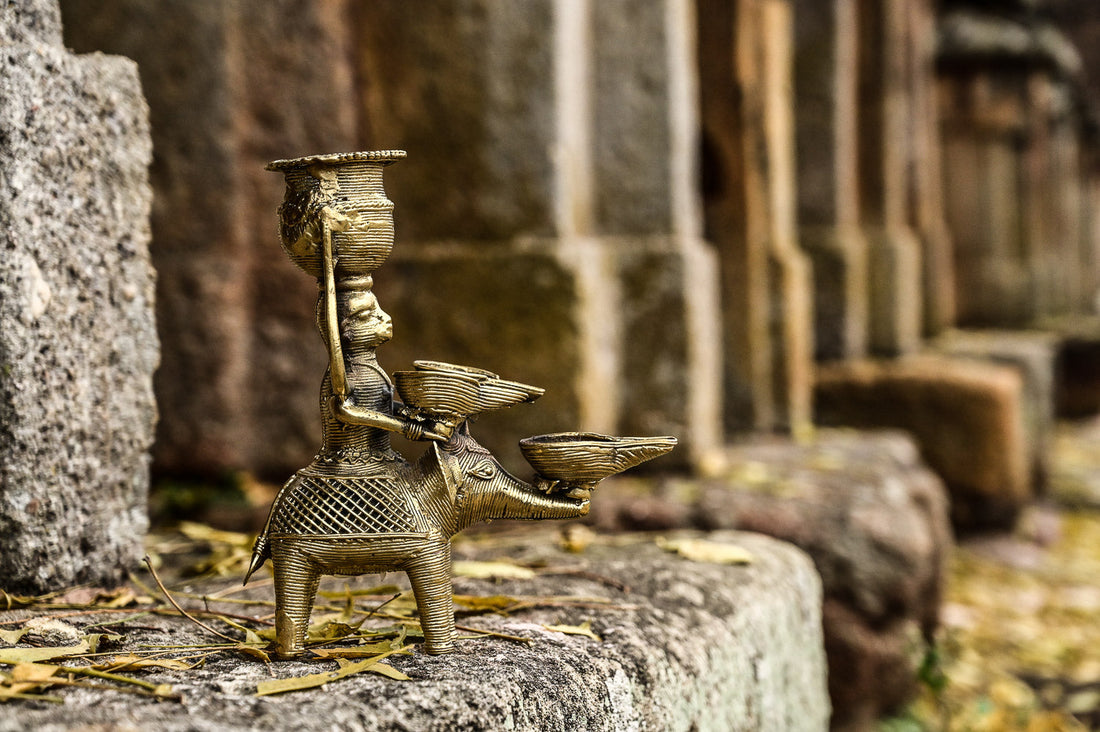
Dhokra Art: A 4,000-Year-Old Craft Still Thriving
India's rich heritage of handicrafts and tribal art is a testament to its deep cultural roots and timeless traditions. One of the most fascinating and ancient art forms that continues to thrive in modern times is Dhokra art—a craft that has survived for over 4,000 years and still captures the imagination of collectors, designers, and art lovers around the world.
In this blog, we’ll explore the history, process, significance, and contemporary relevance of Dhokra art, and how supporting such crafts is essential for preserving India’s cultural legacy and empowering its artisans.
What is Dhokra Art?
Dhokra (or Dokra) art is a type of tribal metal casting practiced using the lost-wax technique. The craft derives its name from the Dhokra Damar tribes, the traditional metalsmiths of West Bengal, Odisha, Chhattisgarh, and Jharkhand.
These artisans create handcrafted brass artifacts that are often symbolic, spiritual, and inspired by nature and tribal folklore. What sets Dhokra apart is its raw, earthy aesthetic, non-repetitive detailing, and the fact that no two pieces are ever exactly the same.
The 4,000-Year-Old Legacy
The earliest known example of Dhokra art is the famous “Dancing Girl” of Mohenjo-Daro, a 4,000-year-old bronze figure from the Indus Valley Civilization. Since then, this ancient Indian handicraft has continued through generations of tribal artisans, using the same fundamental techniques.
Despite the rise of mass production and machine-made decor, Dhokra art has never vanished. Its survival is a tribute to the passion of the artisans who preserve their ancestors' knowledge, passing it down through oral tradition and hands-on practice.
The Lost-Wax Casting Technique
One of the reasons why Dhokra art is so unique is because of the complex process behind each creation. Here's a brief overview of how each piece is made:
-
Creating the core: Artisans start by making a rough clay model, which forms the base shape.
-
Wax modeling: The clay core is then layered with beeswax or resin, which is intricately sculpted to form the desired patterns and motifs.
-
Cladding with clay: Another layer of clay is added over the wax, forming a mold.
-
Heating and casting: The mold is baked, allowing the wax to melt and drain, leaving a cavity.
-
Molten metal filling: Molten brass is poured into the cavity to take the shape.
-
Finishing touches: After cooling, the outer clay layer is removed, and the object is polished by hand.
Each step is done manually, which is why Dhokra artifacts are truly one-of-a-kind and highly valued by collectors.
Why Dhokra Art Matters Today
In a world dominated by factory-made decor and fast fashion, handmade Indian handicrafts like Dhokra stand out for their authenticity, sustainability, and cultural value. Here’s why this traditional craft remains relevant:
1. Sustainable Craftsmanship
Dhokra art uses natural materials, including beeswax and clay, and is produced in small batches, leaving a much smaller carbon footprint compared to mass-produced decor.
2. Cultural Preservation
Every piece of Dhokra art tells a story—whether it's a tribal deity, an animal from the forest, or a scene from rural life. Buying Dhokra supports the preservation of Indian tribal culture and mythology.
3. Supporting Artisans
When you buy Dhokra products from platforms like Atulya Karigari, you’re directly supporting Indian artisans, many of whom rely on this craft as their sole livelihood. This promotes fair trade, financial empowerment, and cultural dignity.
Dhokra in Modern Home Decor
Today, Dhokra metal art is not just a traditional showpiece—it’s a statement of elegance and heritage. From wall hangings and tabletop decor to tribal jewelry and functional pieces like lamps and pen stands, Dhokra art fits perfectly in modern, minimalist, and ethnic home interiors.
Styling Ideas:
-
Place a Dhokra figurine on your study table for a rustic yet regal vibe.
-
Pair a Dhokra bull or elephant sculpture with Sabai grass baskets for a striking fusion of materials.
-
Use Dhokra candle holders or lamps to bring warmth and culture into your living room.
Where to Buy Authentic Dhokra Art
When purchasing authentic Dhokra artifacts, it’s important to buy from trusted sources that promote genuine, handmade Indian handicrafts. At Atulya Karigari, every piece of Dhokra art is:
-
Handmade by skilled tribal artisans
-
Sourced directly from craft clusters in Odisha and Chhattisgarh
-
Ethically priced and fair-trade certified
-
Perfect for gifting, home decor, or cultural collecting
Atulya Karigari also offers a curated collection of other Indian crafts, including Pattachitra paintings, Sabai grass baskets, Golden grass products, and handloom sarees like Banarasi silk, Khandua silk, Tissue, and Georgette sarees—each with a story and soul of its own.
Final Thoughts
Dhokra art is not just a craft; it’s a connection to India’s ancient roots, tribal traditions, and timeless creativity. In choosing Dhokra, you are choosing to support sustainability, artisanship, and cultural continuity.
As global interest in handmade Indian handicrafts rises, it’s time to give Dhokra the spotlight it truly deserves. Let’s keep this 4,000-year-old art form thriving, one handcrafted piece at a time.
